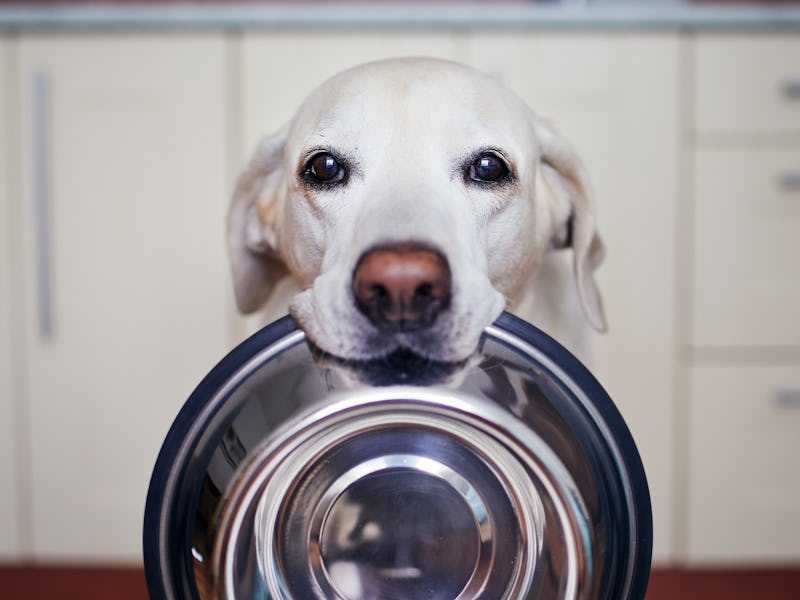You're probably handling your pet's food wrong, new study finds
Most pet owners don't follow FDA food handling guidelines.

Dog owners, beware: You’re probably doing at least one thing wrong when it comes to handling your pet’s food.
Improper pet food handling could have serious implications for canine and human health, but most canine owners aren’t aware they’re even doing anything wrong, according to a study published Wednesday in the journal PLOS ONE.
“Pet owners should know that pet food bowls can harbor bacteria and that recommendations exist for minimizing that risk,” Emily Luisana, the lead author of the study and a researcher at North Carolina State University’s College of Veterinary Medicine, said in a press statement.
What’s new — According to the data, most dog owners are missing out on some pretty basic hygiene protocols when handling their pet’s food. Only 4.7 percent of pet owners surveyed were aware of Food and Drug Administration (FDA)’s pet food handling guidelines.
The FDA’s guidelines include recommendations on how to safely store and prepare pet food, as well as hygiene protocols such as washing pet dishes, to minimize foodborne illnesses. For example, some FDA recommendations include storing dry pet food in a cool place, tightly covering refrigerated pet food, and washing and drying pet food utensils with soap and hot water after each use.
You should also wash your hands with soap and hot water for at least 20 seconds before and after handling your pet’s food. The guidelines also include recommendations on reporting issues with purchased pet food. You can read the full recommendations here.
While three-quarters of owners did some things right — such as avoiding raw food and tightly covering leftover pet food — only 22 percent reported washing pet food dishes weekly. When participants did wash the food dishes, they most likely used warm soap and water or the dishwasher. Most alarmingly: Only 34 percent of respondents washed their hands after handling the food.
Nearly as shocking were the owners’ food preparation and storage practices. Nearly 35 percent of dog owners said they prepared their dog’s food on the same surface where they prepare food for human members of the household. More than 40 percent washed their pet’s dishes in the same area as human dishes or stored their dog’s food five feet or less from human food.
Some of the participants followed FDA-approved hygiene protocols, but even then, only 8 percent of those dog owners said they were likely to follow through with the guidelines long-term.
“Our findings confirmed that most pet owners are unaware that the FDA has pet food hygiene and storage recommendations,” Luisana said.
The study’s findings revealed that most dog owners are not aware of safe pet food handling guidelines, including washing hands and dishes after feeding pets.
Why it matters — It might seem like a lot of fuss over kibble bowls, but as it turns out, improper handling of pet food could have serious health implications.
“For example, there have been multiple outbreaks of both humans and dogs becoming ill after exposure to dog food contaminated with pathogenic bacteria,” write the study authors in the paper.
Cross-contamination of dog bowls and human food surfaces, as well as irregular washing of hands and dishes, could lead to the transmission of dangerous bacteria such as Salmonella and E. Coli. Younger children and immunocompromised individuals are particularly vulnerable to this bacteria. The study reported that 35 percent of respondents had immunocompromised individuals or children younger than 12 in their households.
However, the researchers note that the risk of bacterial contamination goes down significantly when dog owners adhere to proper dishwashing protocols. The FDA recommends washing pet food bowls after each use, and washing water bowls daily. Wash your hands after feeding your pet. According to the study, washing with hot water greater than 160 ̊ F or 71.1 ̊C reduced bacteria counts more than using cold water.
“This study suggests a need for pet food handling and dish hygiene guideline education to minimize bacterial contamination of dishes, especially for high-risk populations,” write the study authors.
How they made the discovery — Luisana’s team recruited dog owners to participate in a survey regarding the handling of their pet’s food. Ultimately, 417 pet owners participated in the survey.
The researchers also collected data from swabs from more than 60 pet food dishes, performing what’s known as an aerobic plate count — a scientific method to measure bacteria in a sample. Participants’ samples were assigned into three groups, with Group A and B following the FDA pet food handling guidelines, while Group C did not adhere to any guidelines.
Luisana explains why her team decided to study dog owners’ knowledge of food handling protocols — as it turns out, many veterinarians were unaware of FDA recommendations on the topic.
“Once we realized that these recommendations were relatively unknown even among professionals, we wanted to see what other pet owners were doing,” Luisana said.
What’s next — The findings may be alarming, but there is a productive way forward for dog owners to keep themselves and their pets safe.
Since many owners reported that they would likely to their veterinarians and pet food stores for recommendations regarding food handling, the researchers suggest FDA guidelines be made available for dog owners to view in these locations and on their websites. Further studies could identify ideal cleaning and storage recommendations and suggest tips on communicating guidelines to pet owners.
“I hope this study makes pets happier and healthier,” Luisana concludes.